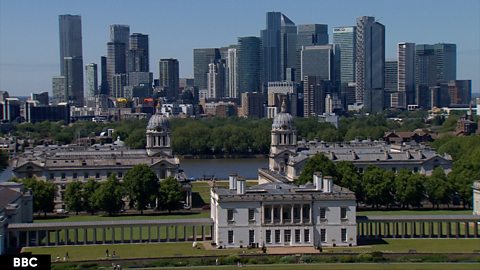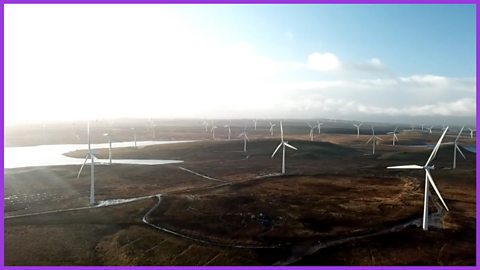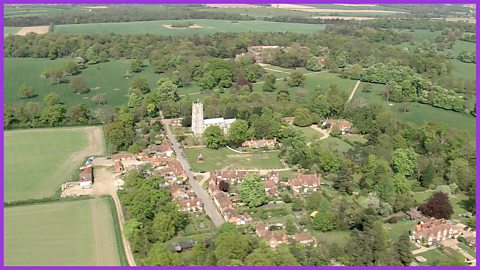Join EVA ('Earth's Virtual Assistant') to investigate and contrast two different types of settlement - cities and holiday resorts.
The video
KS2 Geography: Settlements. Cities and Holiday resorts.
EVA: Get set for an exciting journey.
I’ll be your guide, ‘Earth’s Virtual Assistant’. But you can call me E.V.A.
Your mission is to explore different types of settlement. Settlements are places where people live and sometimes work. They can be small, or large, depending on how many people live there and what sorts of services there are.
[ON-SCREEN GRAPHICS - SERVICES]
Services meet different needs, like healthcare or education.
Let’s investigate a city settlement.
[THE GLOBE SPINS AND WE ZOOM INTO UK]
It’s time to start this mission so let’s journey to the United Kingdom.
There is no single definition of what a city is. In the past, if a settlement had a cathedral it could be called a city, no matter how big it was or how many people lived there. For example, St Davids in Wales is a cathedral city, with a very small population of just under 2,000 people.
But today, a city is usually thought of as a very large settlement that has lots of buildings and lots of people.
[ON-SCREEN GRAPHICS - CITIES ACROSS THE UK]
Swansea is a port city in Wales. It has a population of around 250,000.
Belfast is the capital - and the largest city - in Northern Ireland. It has a population of around 350,000.
Located on the River Clyde, Scotland’s largest city is Glasgow. It’s home to more than 630,000 people.
[ON-SCREEN GRAPHICS - CITIES]
Large cities are usually known for trade and economic activity. You’ll often find tall high-rise buildings used as offices for people to work in.
Not all of the high-rises are used for work, as lots of people also live in cities, often in flats or apartments.
Large cities have the greatest variety of buildings and services inside them. They usually have hospitals, sports facilities, and tourist attractions like museums.
There are lots of transport links connecting cities with other parts of the country, as they’re important hubs for people to get to. Some cities even have their own airport.
The world’s largest cities have a special name. They’re called megacities.
[ON-SCREEN GRAPHICS - MEGACITY]
The UK’s capital - London - is a megacity…and it continues to grow!
Some people live in the outskirts of a city, called the suburbs…
[ON-SCREEN GRAPHICS - SUBURBS]
…where there’s more green space. People in suburbs tend to live in houses, rather than apartments or flats.
Cities do face challenges. So many people living and sharing the same space can lead to pollution. This could be increased noise, or litter or exhaust fumes from so many vehicles on the roads.
[DEBRIEF - CITIES]
1: Cities are usually large settlements known for trade and business. 2: But can also have historic and cultural importance. 3: Large cities have tall, high-rise buildings, and a wide variety of facilities and services.
[ZOOM OUT TO MISSION HQ]
Our mission continues now and it’s time to explore another settlement. Who’d like to go on holiday?
[WE ZOOM OUT TO A HOLIDAY RESORT]
Holiday resorts can be found in coastal areas, or places which offer beautiful landscapes. They can also be close to historical cities with interesting things to visit. They can vary in size but their main purpose is tourism.
[ON-SCREEN GRAPHICS - RESORTS]
Many holiday resorts in the UK developed during the reign of Queen Victoria, when more people could now afford to take holidays and transport had improved to make travel easier.
The number of people in holiday resorts varies across the year, depending on when tourists wish to visit them. For example, in the seaside resort of Blackpool in England, lots of people visit in the summer when the weather is nicer.
Blackpool is home to around 140,000 people, but over 20 million tourists visit throughout the year. This means there’s a huge difference between the permanent population in holiday resorts, and the number of annual visitors.
[ON-SCREEN GRAPHICS - TOURISM]
To be successful a holiday resort needs to provide the services its visitors need. This means having good transport links, places to park cars, but - most importantly - plenty of places to stay, called accommodation, as well as restaurants to enjoy a meal and plenty of leisure facilities.
Sometimes a holiday resort can become so popular that too many people wish to visit, leading to overcrowding and pollution.
[DEBRIEF - HOLIDAY RESORTS]
1: A holiday resort is a type of settlement where people stay for a short time while on holiday. 2: They are often found in coastal areas or areas of outstanding natural beauty. 3: Whether small or large, their main purpose is tourism.
[ZOOM OUT TO MISSION HQ]
Congratulations! We’ve come to the end of our fabulous journey exploring two different types of settlement. Mission complete!
Cities and Holiday resorts
Download/print a transcript of this episode (pdf).
Pupils join EVA ('Earth's Virtual Assistant') to discover the defining characteristics of two different types of settlement: cities and holiday resorts.
Pupils will discover that:
- cities are larger than both villages and towns
- that there is no single definition of what a city is (for example, any settlement that includes a cathedral may be called a city)
- that the largest cities are classified as megacities
- that cities offer the greatest range of services: healthcare, education, shops, leisure facilities, places of worship, etc
- that the population of holiday resorts can fluctuate greatly depending on the time of year
- that holiday resorts prosper when they provide the services required by visitors
- that tourism can lead to issues such as pollution.
Teacher Notes
Download/print the full Teacher Notes with worksheets for this episode (pdf).
Teacher Notes prepared in partnership with the Geographical Association.
Key geographical vocabulary
Settlement - a place where people live and/or work.
Land use - how land is used by humans.
Recreation - something that provides fun, leisure, entertainment value.
Commercial - something that makes money.
Rural - areas beyond urban areas that are more remote with few houses, lots of green space and limited facilities.
Urban - built up areas with lots of housing, large populations, lots of facilities and services.
Facility - a place with a specific use, eg hospitals, schools.
Service - a helpful activity provided to people, eg public transport, education, healthcare.
Holiday resort - a place that is popular with tourists.
City - a specialist or busy urban area, usually larger than a town.
Suggested activities
- Complete a comparison chart between cities and holiday resorts. Include: transport, types of buildings, population, why people are here, jobs, leisure activities.
- Give pupils an OS Map (either paper copy, or on-screen using Bing Maps) that shows a city settlement. Play a grid reference game to see who can spot different features from the map - eg ‘What grid reference has a church/supermarket/train station/hospital, etc?
- Have students create Top Trumps cards for different settlement types (village, town, city, holiday resort) that include scoresfor categories such as: entertainment, transport, healthcare, education, pollution, green space. Then compare to each other and compete.
- Design a city, or design a holiday resort. Work individually or in pairs or groups with large sheets of paper to design their own city or resort. Include what essential services their settlement needs - eg transport, entertainment, jobs, green space, healthcare, etc. Draw an aerial view/ map of the settlement including a key.
Points for discussion
- What makes a city?
- Are all cities big with lots of people?
- What kinds of facilities or services do cities usually have that you would not find in a village or town?
- Why have holiday resorts developed?
- What do tourists look for in holiday resorts?
- What problems can be created in busy cities?
- How have humans changed the landscape in cities?
- What facilities should a holiday resort have?
- What problems can be created in holiday resorts?
- What is a megacity?
- Where are holiday resorts found near to?
- How does the population change during busy tourist seasons?
Curriculum notes
This video is suitable for teaching KS2 in England and Northern Ireland, 2nd Level in Scotland and Progression Step 3 in Wales.
Resources
Teacher Notes
Download/print the Teacher Notes for this episode (pdf).

Transcript
Download/print a transcript of this episode (pdf).

Slideshow. image
Open a slideshow of images from this unit.

Other videos in this series
Settlements: Changing land use. video
Join the mission to investigate the factors governing changing land use, including increasing urbanisation.

Settlements: Villages and Towns. video
Join the mission to investigate two different types of settlement: villages and towns.

See also... Biomes. collection
Join EVA on another mission: to discover the climate, plants and animals that characterise six of Earth's major biomes including rainforests, deserts and savannahs.
